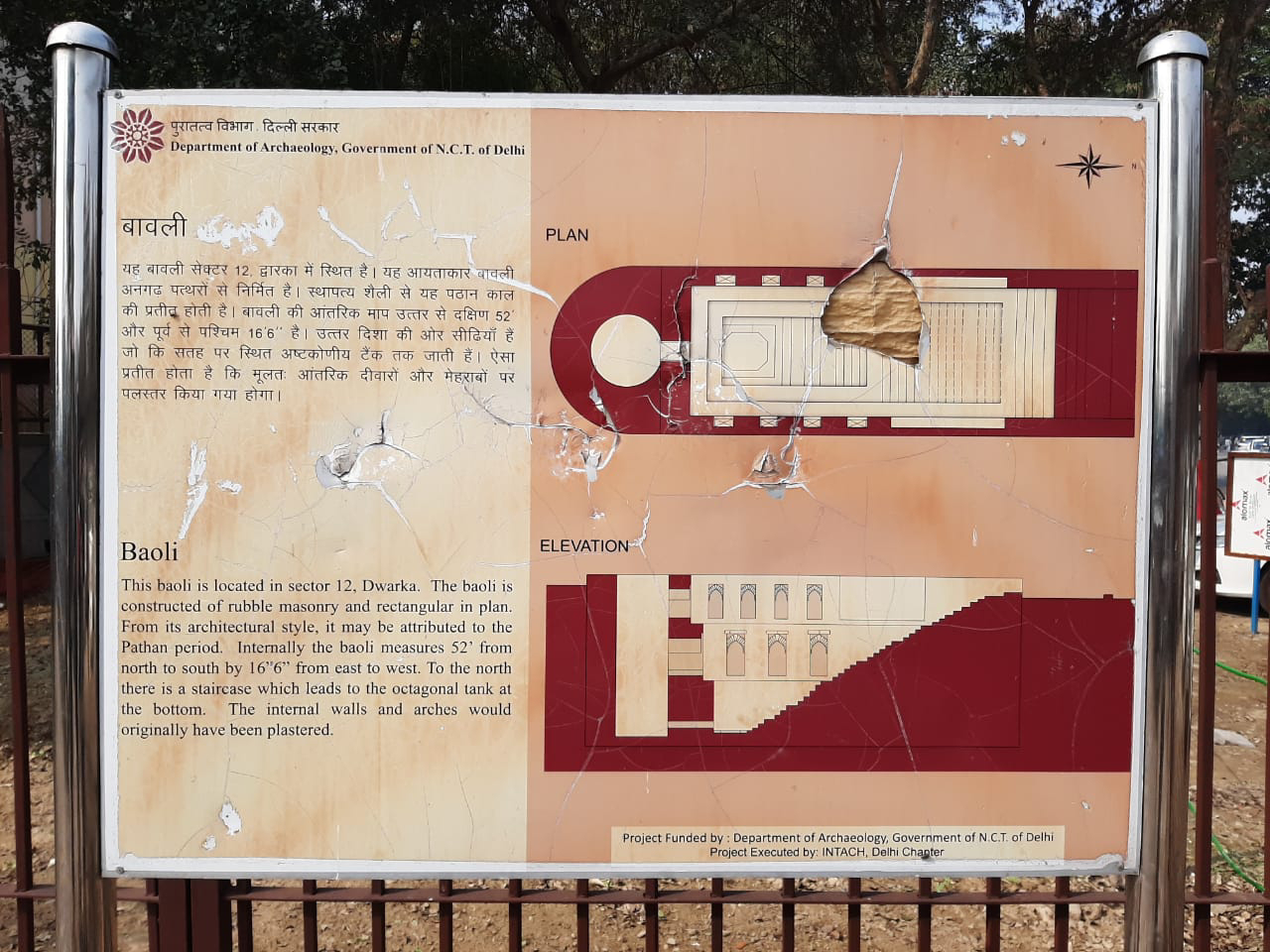“It was Built by the Pathans”: What We Know About the Dwarka Baoli Blog Report by Diptarka Datta
“Issko pathaano ne banwaya tha. Usse zyada toh kuchh pata nahi.”
[This (baoli) was built by the Pathans. I do not know anything more about this.]
There is probably only this much that one knows about the Dwarka Baoli. The information board put up by INTACH and the State Archaeology Department also could not tell us anything more about who might have actually patronized the construction of this Baoli, than what the caretaker at the site told us. Thus, when the ancient past of this Baoli failed us, we thought it worthwhile to reconstruct its modern histories—what one would otherwise call its “afterlife.”
Figure I: The information board at the Baoli
Who are we? Why are we here, at the Dwarka Baoli? I do not think our “Baoli Gang” (read, Baoli girls) needs much introduction now (if you do not already know who the “Baoli Gang” is, a reading of the previous blog articles is highly recommended!). After covering multiple Baolis in Delhi, this was decidedly the last leg of our baoli expeditions. And here was I, so far only active in the Whatsapp group, who decided that it is a “now or never” scenario so far as my engagement with this project is concerned. And thus I packed my bag and joined the Baoli girls in another round of adventure!!
Before reaching the site, I was being warmed up with stories of past adventures, (or should I say, “mis-adventures”?) featuring locked doors, suspicious work staff, ferocious dogs and raucous monkeys. As if this was not enough, there came a Whatsapp message on the group: “Please beware of dogs, cats, monkeys and humans!” Nevertheless, when we did reach the site, it was all in place and there seemed nothing much to worry about. Hallelujah!!
Figure II: A view of the Dwarka Baoli, showing the rubble-masonry walls and stairs
The auto drivers knew about the baoli and we could easily reach there. The site was not closed. It was also quite well-maintained. The INTACH board at the site was quite reassuring (you do not know how skeptical I am about the ASI and whatever it does!). The watchman at the site was quite welcoming. Maybe I proved lucky for the “Baoli Gang”!!
The rectangular baoli is made up of rubble masonry and has a staircase from the north leadig to the octagonal tank at the bottom. Internally, it measures 52’ from north to south by 16’6” from east to west. We started with our usual work. Simran and Medha took videos. I started clicking photos. Rattan was there, with her notebook, guiding us and suggesting interesting observations (not to mention, occasionally flexing her specialized knowledge on conservation and heritage management!). Rattan would draw our attention to random scribblings reading “mandir” and all, and something we thought was salt deposited on the walls along the baoli stairs. We could also take a short interview of the caretaker of the site. Upon inquiry, he told us how he makes sure no one damages the site, throws garbage or scribbles anything on the walls (reminded me of the “mandir” we had just seen, written deep down the baoli’s walls!). He gets the site cleaned occasionally every month and claims that the site is never that dirty. There also seemed to be some kind of satisfaction with the restoration work the INTACH and the Archaeology Department have done at the site.
Figure III: Some evidences of what seemed like salt (left); scribbling on the walls (right)
So, I was talking about the modern history of the site, right? What is this modern history? Interestingly, this baoli was brought to public attention and restored only some five-six years ago, as the watchman told us. Before that, it was all hidden under heaps of rubble and rubbish. I can totally imagine a group of young and old people forming an eager crowd, trying to found out what all is being dug up and unearthed at the site. There might even have been some kind of antique collection drive and scope for casual loots! Furthermore, the baoli is placed inside a walled space, surrounded by the backs of buildings on all three sides. Imagine you sitting at your balcony, sipping tea and observing a medieval baoli. It is that exciting. Or you might be a budding poet visiting the site to get some food for thought and maybe end up dedicating an entire poem to the baoli. Thus, a medieval Baoli built by some unknown Pathan ruler ends up finding itself breathing amidst a bunch of multistoreyed flats, beside a road busy with traffic—some of which includes autos carrying passengers to the Dwarka Sector 12 metro station. Its only identity—it was built by some Pathan ruler.
Our work at the site got over unexpectedly and surprisingly early. We had enough time now to seek leisure and well, “chill”! We got into our gossiping mode and chatted over servings of pav-bhaji and delectable desserts. We could not praise the Dwarka baoli enough for treating us so well (we, otherwise, having been haunted and hounded away at every other site). Soon, it was time for us to board the metro and get back to our respective places.
Figure V: The final shot: the “Baoli Gang” at the site
As the day neared its end, I thought how can we, as heritage enthusiasts and young researchers, try tease out histories of the Dwarka Baoli. We know it was built at the time of the Lodis by the residents of the then village of Loharehri. How to connect the disjointed pieces of information and weave a history of the site is something we seriously need to engage in.
PS: Stay tuned till the “Baoli Gang” embarks upon a new, more exciting project to record some of Delhi’s oldest sites and surroundings.








Comments
Post a Comment